- Home
- J. A. Jance
Dead to Rights Page 5
Dead to Rights Read online
Page 5
“What happened?” she asked.
“It’s too soon to tell. The fire crew is mopping up inside. One of the firemen discovered the body. Bebe Noonan…” Voland paused long enough to consult a notebook. “Full name’s Bianca Noonan—the young woman over there with the horse—is the one who reported the fire. If you’re looking for heroes, she’s it. She found Morgan lying just inside the door to the barn and dragged him outside. She also rescued the horse.”
Following Voland’s glance, Joanna saw that Bebe Noonan had untied the skittish gelding and was leading him to the far end of the parking lot, where she tethered him to the chain-link fence that marked the westernmost boundary of the animal clinic property. Even there, she remained with the animal, alternately petting him and clinging to his neck.
Joanna turned to the fire chief. “How soon do you think we’ll be able to get inside?” she asked.
“The fire’s out, except for a couple hot spots, but we’ll have to check for structural damage before we can let anyone else go inside. I’ll let you know.”
Lowrey walked away, leaving Joanna and Dick Voland alone. The chief deputy waited until the other man was out of earshot before he attacked. “You never should have ordered Pakin off the case,” he said. “Obviously the incident was far from over…”
Joanna knew full well that the only way to survive with Dick Voland was to push back. “No Monday-morning quarterbacking, Dick,” she snapped. “That particular incident was over. You know as well as I do that we don’t have the manpower to have one deputy spend his whole shift waiting to see if something might happen.”
“Well,” Voland said derisively, motioning toward the still smoldering hulk of a barn. “If you call this over, I’d hate to see what you call an ongoing.”
Joanna had to struggle to maintain her composure. “Look, Dick,” she said, “you’ve made your point. Now how about getting down to business and telling me precisely what went on.”
“Bebe came to work at noon,” he said. “She evidently works afternoons and most weekends. That’s her little brown Honda parked over there by Doc Buckwalter’s van. She said she parked her car, went inside the clinic, and was getting things lined up for the afternoon appointments. Bucky wasn’t here, and neither was Terry, but she didn’t think anything about it.
“About a quarter to one or so,” Voland continued, “she looked out the window and saw smoke pouring out the door to the barn. She called nine-one-one right away to report the fire and then came running out here to make sure the doc’s horse was all right. She went in to let the horse out of his stall. That’s when she stumbled over Morgan. He was lying on the floor just inside the door. If she hadn’t dragged him outside, he’d probably be a goner now, too, instead of just on his way to the hospital.”
“Smoke inhalation?” Joanna asked.
Voland nodded. “That and an egg-sized knot on the back of his head.”
“Somebody hit him then?” Joanna asked, thinking that someone else, a third party, must have been in the barn with the other two men.
Voland scowled and shook his head. “Most likely he cracked the back of his head on the cement floor when he fell. Anyway, according to Ben, the fire was mostly confined to the tack room and to the hay and grain stored at the far end of the barn. It made for lots of smoke, although, as you can see, there’s not much damage to the front of the building.”
Joanna swallowed hard before she asked the next question. “What about Terry? Is there a chance she’s in there as well?”
“Maybe, maybe not,” Voland replied. “According to Bebe, she drives an old T-Bird. Since it’s not in the parking lot, we’re hoping she went somewhere. I’ve got people looking for her right now.”
Joanna found herself praying that Terry Buckwalter was safe, that her body wouldn’t be found among the ruins. It was bad enough that one person was dead. If there were two…
Unable to speak, Joanna studied the roofline of the building, especially the noticeably sagging far end. She had been inside this particular barn only once, several years earlier, shortly after it was completed.
Bild-a-Barns were the construction equivalent of fast food. They came from the modular school of design and were shipped in lots made up of prefabbed numbered pieces. Once at a site, they came together like a giant Erector set, clipped together over concrete slabs and preassembled metal frames.
Bild-a-Barns came in several different styles and configurations. They could be as small as one stall and one storage room or as large as ten stalls, depending on how many sections the owner was willing to fasten together. This one was a five-stall/tack room version, giving Bucky Buckwalter enough room for Kiddo along with space left over to board four additional animals.
Joanna remembered the barn dance the local Rotary Club had thrown in conjunction with the completion of the building. They had staged an old-fashioned square dance complete with a live band and a traveling barbecue outfit that had been trucked in from Tucson. The proceeds had been used to benefit the local Little League.
On that happy occasion, Bucky Buckwalter had been extraordinarily proud of the latest addition to his clinic. At the time, no one could possibly have predicted that three or four years down the road, that same barn would be the site of its owner’s death. And not just death, either, Joanna corrected herself. The site of Bucky’s murder.
Joanna was so lost in contemplation of both the damaged building and her own thoughts that she almost didn’t hear Dick Voland’s question. “Are you all right?”
His sudden show of concern caught Joanna totally off balance. “I’m okay,” she answered quickly. “But you’re right, you know. All this is my fault.”
“No, it’s not,” Voland returned quickly, with almost no trace of his customary gruffness. “Forget what I said earlier. Sure, it’s easy as hell to have twenty-twenty hindsight in situations like this. Our manpower’s spread way too thin to have a deputy stand around all day holding some damn protester’s hand. What’s important, though, is that we’ve got the perpetrator. It’ll save Ernie the time and trouble of going looking for him.”
Trying not to betray how much Voland’s unexpected kindness had affected her, Joanna turned away and glanced around the parking lot. “Where is Detective Carpenter, by the way?” she asked.
Ernest W. Carpenter—Ernie for short—was Cochise County’s sole homicide investigator. “He and Deputy Carbajal are on their way back from working that natural-causes stiff up in Sunizona,” Voland answered. “According to Dispatch, they should be here within a matter of minutes. The last I heard, they were still fifteen miles out.”
At the far end of the parking lot, Bebe Noonan continued to work at calming the panicky horse. The two of them, woman and horse, were just beyond Bucky’s Ford Econoline van.
Joanna started across the parking lot, heading for Bebe. “Come get me as soon as Lowrey clears it for us to go inside.”
“Us?” Voland asked after her.
“Us,” Joanna repeated wearily.
She knew full well the need of keeping the number of crime-scene visitors to a minimum. Unfortunately, she also understood the need for people in her department and in the community at large to see her as a “real” police officer—as an active player and investigator rather than as a mere figurehead.
“If you say so,” Voland replied. Joanna could tell by the change in the tenor of his voice that he didn’t approve, but he accepted her decision without argument. “Where are you going to be?” he asked.
“Right now I’m going to go talk to Bebe,” Joanna said.
Leaving Voland alone, Joanna picked her way across the parking lot. The high heels she had worn for the board of supervisors meeting proved hazardous in the loose gravel and ankle-twisting potholes. By the time she reached the chain-link fence, Bebe had finally succeeded in calming the skittish horse. He was standing still while Bebe rested her head against his chestnut-colored neck.
Bianca Noonan was a slight, painfully thin young woman in
her early twenties. Mousy hair, a slight overbite, and close-set eyes all combined to make her less than beautiful. She was crying. Her narrow, tearstained face was smudged by smoke, with rivulets of tears cutting through the grime.
“Bebe?” Joanna said tentatively.
The young woman straightened up and shot Joanna a despairing look. “Dr. Buckwalter’s in there dead, isn’t he,” she said.
“Someone’s dead,” Joanna replied carefully. “We still don’t know for sure who it is.”
“But it has to be him,” Bebe insisted. “I mean, who else could it be? Dr. Buckwalter’s van is here and he’s not. I already looked through the whole clinic. He’s not in there. Not anywhere.”
“We won’t be able to find out for sure until the fire chief lets us go inside the building to check. Until we make a positive identification of the victim, it’s best not to speculate. Meanwhile, we’re going to need your help.”
Bebe nodded mutely.
“Chief Deputy Voland said you were the one who discovered the fire. Is that true?”
Bianca Noonan nodded again. “I also found the other man. When I went into the barn to get Kiddo, I stumbled over him. There was so much smoke that I couldn’t see. I fell right on top of him. At first I was afraid he was dead. The only thing I could do was grab him by one arm and drag him outside. Then I went back in for Kiddo. I saw the ambulance leave. Is the man all right?”
Joanna shook her head. “We don’t know that, either,” she said. “As soon as we hear something, I’ll let you know.”
For several seconds, Joanna and Bianca stood there in silence. “What about the clinic?” Joanna asked finally. “When you went in there, was there anything amiss—anything out of place, or else anything in there that didn’t belong?”
Bebe shook her head. “Nothing,” she answered. “As far as I could tell, everything seemed fine.”
The young woman shuddered and took a ragged breath. “I guess you could go inside and look for yourself, Sheriff Brady,” she offered. “I have the keys right here.”
“No, that’s not necessary,” Joanna said hurriedly. “We shouldn’t do that. We might inadvertently disturb some important piece of evidence. Detective Carpenter will be here in a few minutes. He’ll need to go through it, of course. Until then, however, the fewer people inside, the better. The detective will probably want to talk to you as well.”
The horse stirred restlessly. “It’s okay, Kiddo,” Bebe said, stroking the horse’s long, smooth neck. That action seemed to have as much of a soothing effect on the fearful young woman as it did on the horse.
“But I already told Deputy Voland everything I know,” Bebe objected.
“What about Mrs. Buckwalter?” Joanna asked. “Her car isn’t here in the lot. Where is she?”
Bebe sniffed and brushed away tears. “Like I told Mr. Voland, it’s Tuesday,” she said. “Terry’s pro’ly off playing golf. That’s what she does most afternoons.”
“Where?”
“At that new place out by Palominas—the Rob Roy. She plays there three or four times a week—for sure on Tuesdays, Thursdays, and Fridays.”
Several years earlier, a wealthy and decidedly gay couple—motorcycle-riding California transplants with more money than good sense—had shown up in Cochise County prepared to buy a golf course. When their initial plan to buy one course was derailed at the last minute, they bought themselves a chunk of cow pasture along the San Pedro River where they built a brand-new state-of-the-art course, starting from the ground up.
Locals who had grumbled and gritched and said it would never work had long since been proved wrong. Rob Roy Links—named after a gloomy biker-frequented bed-and-breakfast in Folkstone, England—had become a rousing success. Peter Wilkes, the younger of the two, served as the resident golf pro, while his partner of twenty years’ standing, Myron Thomas, along with Esther Thomas, Myron’s seventy-something mother, ran the food concessions.
The course was so well-maintained and the food so outstanding that the Rob Roy had become the county’s destination golf course and a popular watering hole/dining establishment as well. Not only had it attracted a loyal local following, it was also frequented by golf-crazy touring gays who sometimes stayed for weeks at a time in one of the Rob Roy’s five standalone casitas.
Over time even the most recalcitrant local golfers had been won over. Members of the two vastly divergent clienteles—locals and visiting gays—mingled together in tee-time forged foursomes under the same rule that applied to the armed forces: “Don’t ask, don’t tell.” As Peter Wilkes liked to point out on occasion—the rule might be new to the army, but it was one of golf’s enduring traditions of etiquette.
“Do you want me to call out there and talk to Terry?” Bebe Noonan offered. “I could pro’ly get Mr. Thomas to go get her off the course to tell her what’s happened.”
Joanna shook her head. “Not right now,” she said. “It’s too soon. We should have some kind of positive ID before we do that. Even if the dead man does turn out to be Dr. Buckwalter, we try not to deliver that kind of news over the telephone. It’s better if someone talks to her in person.”
Bebe nodded dully while a new cloudburst of tears streamed down her cheeks. “I understand,” she said.
“Sheriff Brady,” a man called from behind them.
Joanna turned in time to see Detective Ernie Carpenter come trudging across the graveled parking lot. Dressed in his characteristic suit and tie, he carried a small battered suitcase.
“Detective Carpenter,” Joanna said. “This is Bebe Noonan, Dr. Buckwalter’s assistant.”
“The one who discovered the fire?” Carpenter asked, giving Bebe a quick appraising once-over.
When Bebe didn’t reply, Joanna answered for her. “She’s the one.”
Briskly businesslike, Carpenter looked around. “Is there a place where I could change clothes?” he asked.
This time the young woman nodded. “There’s a bathroom right inside the door at this end of the building.”
“Is it locked?”
“Most likely. I can let you in, though. I have a key.”
Leaving the tethered Kiddo on his own, Bebe led Ernie around the side of the building. Moments later she returned alone. “I still can’t believe any of this,” she said. “I’m from out in the valley,” she added. “Things like this just don’t happen out there.”
Joanna felt like telling her that in this day and age no one was immune to crime. The Noonans lived in Double Adobe, just a few miles away from the spot along High Lonesome Road where Andy Brady had been gunned down a few months earlier.
“Is Detective Carpenter the one you were telling me about?” Bebe continued. “The one who’ll be asking questions?”
Joanna nodded. “Right,” she said. “He’ll be in charge of the investigation.”
“But why do I have to answer more questions?” Bebe wailed as more tears spilled down her forlorn cheeks. “Like I said, I already told the deputy everything I know.”
Joanna tried for a reassuring smile. The realities of a homicide investigation were no doubt a long way from Bebe Noonan’s rural experience. Hoping to bolster the young woman’s morale, Joanna attempted to give her a little advance warning of what would take place.
“It will probably seem to you as though the detectives do nothing but ask the same questions over and over. It’s cumbersome, but that’s how the process works. By gathering details from everyone involved, homicide investigators eventually pull together a picture of what really happened.”
“I see,” Bebe murmured.
“Just as long as you tell the truth,” Joanna continued, “you don’t have a thing in the world to worry about. All right?”
There was a long pause. “I’ll do my best,” Bebe replied finally in a strangled whisper. “I promise I will.”
Seconds later, Detective Ernie Carpenter came striding back around the corner of the building. Most of the time, Cochise County’s lead homicide detective look
ed as though he had just stepped out of a department-store window. Sometimes called Gentleman Jim Carpenter, he was forever being teased by his fellow officers for conspicuous overdressing. While other plainclothes officers went for a less formal look with sports coats and maybe an occasional bolo tie, Carpenter customarily turned up at the office wearing brightly polished wing-tip shoes, white shirt, a spotless tie, and a crisply pressed suit.
What went for office attire, however, didn’t work when it came to crime scenes. For those he always carried a little brown suitcase, one he had inherited from his wife, Rose, after her second trip to the Copper Queen Hospital to have a baby. The now battered case went with him everywhere. Called to a crime scene, a dapper Detective Carpenter would arrive, suitcase in hand. Soon he would disappear into a rest room or behind his vehicle. Minutes later, he would emerge looking more like a second-rate plumber than a fashion plate.
He reappeared now in a pair of denim coveralls, serviceable high-topped boots, and surgical gloves.
“According to Ben Lowrey, we’re about ready to go in, Sheriff Brady,” he said as he walked past. “Dick says you want to come along, but with all the ashes, soot, and water, I hope to hell you have something else to wear.”
Having wrecked two separate expensive outfits during her first week in office, Joanna had solved the problem by ordering a full-length coat from an ad at the back of one of Eleanor Lathrop’s many back issues of Sunset magazine. The fully washable J. Peterman coat—what the ad called a cowboy duster—had arrived with sleeves that hung four inches beyond Joanna’s fingertips and a tail that dragged on the ground. Joanna’s mother-in-law, Eva Lou Brady, had cut the coat down to size and then fired up her Singer sewing machine to hem it properly. Following Ernie’s example, Joanna kept the remodeled duster, a pair of worn tennis shoes, and several pairs of thick athletic socks in the back of her Blazer at all times.
Hurrying back out to her own vehicle, Joanna pulled the coat on over her two-piece business suit. She exchanged her heels for socks and sneakers. In less than a minute she was ready to enter the barn with Ernie Carpenter and the others.

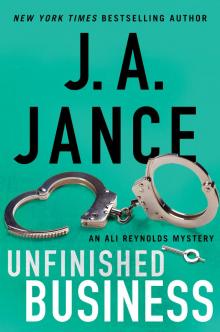 Unfinished Business
Unfinished Business Missing and Endangered
Missing and Endangered Man Overboard
Man Overboard The Old Blue Line
The Old Blue Line Trial by Fury
Trial by Fury Edge Of Evil
Edge Of Evil Field of Bones: A Brady Novel of Suspense (Joanna Brady Mysteries)
Field of Bones: A Brady Novel of Suspense (Joanna Brady Mysteries) After the Fire
After the Fire Deadly Stakes
Deadly Stakes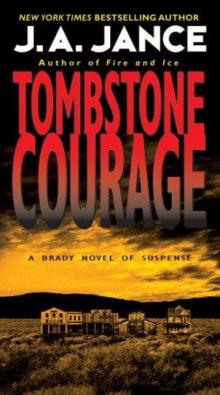 Tombstone Courage jb-11
Tombstone Courage jb-11 Justice Denied
Justice Denied J P Beaumont 16 - Joanna Brady 10 - Partner In Crime (v5.0)
J P Beaumont 16 - Joanna Brady 10 - Partner In Crime (v5.0) Dance of the Bones
Dance of the Bones Exit Wounds
Exit Wounds Left for Dead
Left for Dead Partner In Crime
Partner In Crime Brandon Walker 02 - Kiss Of The Bees (v5.0)
Brandon Walker 02 - Kiss Of The Bees (v5.0) Name Witheld jpb-13
Name Witheld jpb-13 Joanna Brady 01 - Desert Heat (v5.0)
Joanna Brady 01 - Desert Heat (v5.0) Proof of Life
Proof of Life Random Acts
Random Acts Day of the Dead bw-3
Day of the Dead bw-3 Shoot / Don't Shoot jb-3
Shoot / Don't Shoot jb-3 Without Due Process
Without Due Process Fatal Error ar-6
Fatal Error ar-6 Payment in Kind
Payment in Kind Long Time Gone
Long Time Gone Minor in Possession
Minor in Possession Stand Down
Stand Down Judgment Call
Judgment Call Betrayal of Trust jpb-20
Betrayal of Trust jpb-20 Hand of Evil
Hand of Evil Devil's ClawJ
Devil's ClawJ Lying in vait jpb-12
Lying in vait jpb-12 Day of the Dead
Day of the Dead Without Due Process jpb-10
Without Due Process jpb-10 Until Proven Guilty jpb-1
Until Proven Guilty jpb-1 Field of Bones
Field of Bones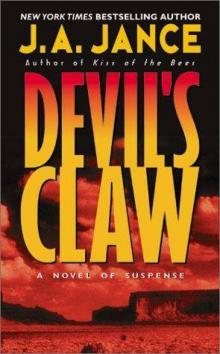 Devil’s Claw
Devil’s Claw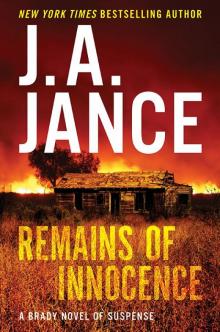 Remains of Innocence
Remains of Innocence Injustice for All
Injustice for All Web of Evil ar-2
Web of Evil ar-2 Paradise Lost jb-9
Paradise Lost jb-9 Improbable cause jpb-5
Improbable cause jpb-5 Skeleton Canyon
Skeleton Canyon No Honor Among Thieves: An Ali Reynolds Novella (Kindle Single)
No Honor Among Thieves: An Ali Reynolds Novella (Kindle Single) Dead to Rights
Dead to Rights Alison Reynolds 01 - Edge Of Evil (v5.0)
Alison Reynolds 01 - Edge Of Evil (v5.0) Ring In the Dead
Ring In the Dead Ring in the Dead: A J. P. Beaumont Novella
Ring in the Dead: A J. P. Beaumont Novella Clawback
Clawback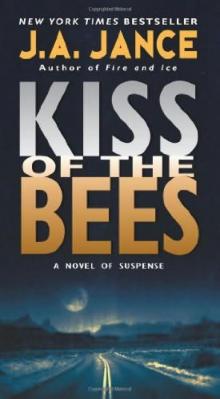 Kiss the Bees bw-2
Kiss the Bees bw-2 Fire and Ice jpb-19
Fire and Ice jpb-19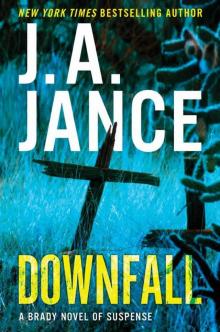 Downfall
Downfall Deadly Stakes ar-8
Deadly Stakes ar-8 Fatal Error
Fatal Error Name Withheld
Name Withheld Duel to the Death
Duel to the Death Cold Betrayal
Cold Betrayal Betrayal of Trust
Betrayal of Trust Web of Evil
Web of Evil Outlaw Mountain
Outlaw Mountain Shoot Don't Shoot
Shoot Don't Shoot A Last Goodbye
A Last Goodbye Ali Reynolds 08 - Deadly Stakes
Ali Reynolds 08 - Deadly Stakes Hour of the Hunter: With Bonus Material: A Novel of Suspense
Hour of the Hunter: With Bonus Material: A Novel of Suspense Trial by Fire
Trial by Fire Exit Wounds jb-11
Exit Wounds jb-11 Hand of Evil ar-3
Hand of Evil ar-3 Failure to appear jpb-11
Failure to appear jpb-11 Tombstone Courage
Tombstone Courage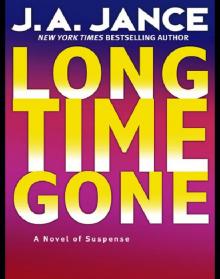 Long Time Gone jpb-17
Long Time Gone jpb-17 Kiss of the Bees w-2
Kiss of the Bees w-2 Edge of Evil ar-1
Edge of Evil ar-1 Cruel Intent
Cruel Intent Improbable Cause
Improbable Cause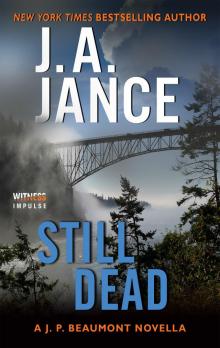 Still Dead
Still Dead Downfall (2016)
Downfall (2016) Justice Denied jpb-18
Justice Denied jpb-18 Damage Control
Damage Control Rattlesnake Crossing
Rattlesnake Crossing Desert Heat
Desert Heat Queen of the Night
Queen of the Night JP Beaumont 11 - Failure To Appear (v5.0)
JP Beaumont 11 - Failure To Appear (v5.0) Until Proven Guilty
Until Proven Guilty Minor in possession jpb-8
Minor in possession jpb-8 Left for Dead ar-7
Left for Dead ar-7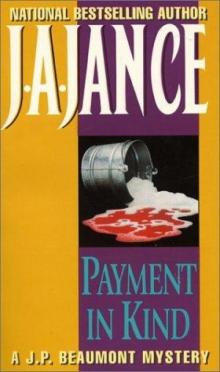 Payment in kind jpb-9
Payment in kind jpb-9 No Honor Among Thieves
No Honor Among Thieves